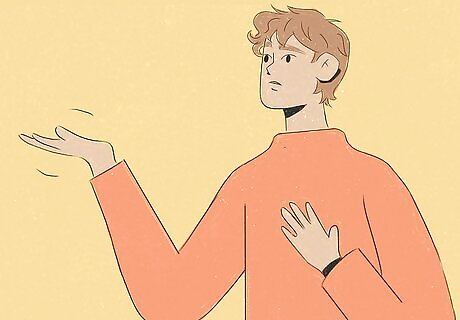
views
X
Research source
Analyzing Emotion in Others

Recognize positive and negative human emotions. There are 6 universal human emotions: happiness, surprise, anger, fear, sadness, and disgust. These fall into two categories: positive (happiness, surprise) and negative (anger, fear, sadness, disgust) emotions. To identify these in others, you need to know what kinds of actions and behaviors they are associated with. These include: Positive emotions reduce stress, improve mood, and increase our memory and awareness. For example: happiness, surprise, sympathy, kindness, love, courage, confidence, inspiration, relief, etc. Negative emotions increase stress, allow us to recognize threats, and deal with challenging situations. Examples are: sadness, fear, anger, contempt, disgust, etc. The two most important regions of the brain for expressing and understanding emotion are the amygdala complex and the prefrontal cortex. Damage to either of these areas can impair someone's ability to read emotion.

Focus on the eyes and mouth. In general, people express emotion through the eyes and/or mouth. The region of the face in which a person displays emotion is influenced by culture. For example, people focus on the eyes in Japan, while people in the United States interpret emotion in the mouth. When reading emotion, look at their entire face and not just the eyes. Stand far enough away so you can see their face, but have a normal conversation. About 1 ⁄2 to 4 feet (0.5 to 1.2 m) is a good distance to keep between yourself and the other person.

Listen to the tone of voice. Next to facial expressions, tone of voice is the second most important way people express emotion. People use their voice to both show and control their emotions. However, some emotions are not conveyed through voice. For example, people can easily identify relaxed, stressed, boredom, contentment, and confidence from tone of voice. Emotions weakly expressed through tone of voice include fear, friendliness, happiness, and sadness. Similar tones of voice can express different emotions. For example, a tense/harsh voice is associated with anger and hostility as well as confidence and interest. A whispery or soft tone of voice can be associated with a range of emotions. These include relaxation, contentment, intimacy, friendship, sadness, and boredom. A soft, breathy voice (where the person takes loud breathes while they talk) is associated with fear, shyness, and nervousness.

Observe and note the general behavior and demeanor. When you look at them, do they portray a friendly atmosphere, or are they more reserved? Emotion can be experienced unconsciously – without you being aware of it. Using your best judgment and going with your gut feeling can sometime be the best way to read emotion. Recognize emotion in others by noting your reaction. Often, we mirror the emotions of others in our facial expression, tone of voice, and behavior. Emotions are contagious. We’re affected by emotion in other people. Our mood and behavior changes depending on how someone else is feeling. This is why if someone smiles at you, you are likely to smile back!

Assess the other person’s physical well-being. Emotions can influence health in both positive and negative ways. If a friend or family member is sick or feels tired all the time, they may be stressed-out or depressed. Physical symptoms of mental illness and depression include: headaches or migraines, low energy, stomach problems, back pain, changes in eating habits, and alcohol or drug use. Mental and emotional symptoms of mental illness and depression include: confusion, sudden and extreme mood changes, isolation from friends, unable to cope with everyday problems, and increased anger or violence.

Develop and improve your emotional intelligence. Teach yourself to recognize emotions in others by becoming more aware of them in yourself. The four branches of emotion intelligence are: (1) be able to perceive emotions in yourself and others; (2) use emotions to promote thinking; (3) understand the significance of emotions; and (4) manage emotions. Strategies to improve emotional intelligence include: Put down your phone and step away from your computer. Improve your social skills and ability to read nonverbal cues by engaging in face-to-face communication on a daily basis. Don’t back away from uncomfortable or negative feelings in yourself or others. These are important and necessary. If you feel sad or angry, step back and think about why you are feeling this way. Then, try to counteract the negative emotion with three positive ones. Listen to your body – a knot in your stomach may be stress, or a fluttering heart may be attraction or excitement. Keep a journal or record of your thoughts and feelings. Several times a week, stop and write down what you are doing and how you are feeling. You can include other information such as how much sleep you had the night before, or what you had for breakfast. Ask a close friend or family member – someone you know and trust – to read your emotions. Sometimes other people know us better than ourselves. Their answers can be surprising and insightful.
Interpreting Facial Expressions

Take note of their facial expressions. How we feel inside is expressed in our eyes and on our faces. Learning to recognize the association between facial expressions and certain types of emotion goes a long way in being able to read emotion. Don’t be fooled! People can manipulate their facial expressions to appear to look happy when they are angry or sad – actors do this convincingly all the time. Look for other cues as to how they really feel. Note their body language or tone of voice. Make eye contact – open, penetrating “cold” eyes suggests a different emotional state than a “warm” smile.

Recognize a genuine smile. A genuine smile uses more muscles than one that is faked or forced. The corners of their mouth and cheeks should be raised. If the muscles around their eyes also tighten and “crow’s feet” form (clusters of wrinkles around the outer corners of eyes), then it is a good indicator of a genuine smile.

Distinguish sadness from happiness. This might seem obvious, but people try to control or cover-up their true emotions by smiling when they are sad. Genuine and spontaneous emotions are hard to fake. Sadness is associated with frowning (lowering the corners of the mouth). It is also associated with raising the inner corners of the eyebrows (near the noise). Additional cues are loose, drooping eyelids that cover part of the eye.

Recognize anger and disgust. Anger and disgust are often associated with one another and create similar facial expressions. We wrinkle our noses when we are disgusted, angry, or annoyed. Anger and resentment can be towards someone or about something. When we are angry, we pull our eyebrows down, purse our lips (tighten them and suck-in the margins), and bulge our eyes. In contrast to anger, expressing dislike, disgust, or disdain for someone or something is associated with a raised upper lip and loose lower lip. We also pull our eyebrows down, but not as much as when we are angry. Reader Poll: We asked 770 wikiHow readers who read body language, and only 8% of them agreed that the best way to recognize anger is when someone furrows their brow. [Take Poll] While this can be an indication of anger, pay attention to other body language as well as their tone of voice.

Recognize fear and surprise. While fear is a negative and surprise is considered a positive emotion, both activate the sympathetic nervous system and trigger a “fight or flight” response. When something unexpected happens, whether it is good or bad, it stimulates a part of the brain that is outside of our direct control. When this happens, we pull up our eyebrows and eyelids so our eyes are wide open. When we are afraid, we also pull our eyebrows in (towards the nose), our pupils dilate (get bigger) to take in more light, and our mouth is open. We also tense up the muscles in our face, especially around our mouth and cheek. When we are surprised, we tend to arch our eyebrows and drop our jaw. Our mouth is open, and the muscles around it are relaxed and loose.
Reading Emotion in Other Ways

Look for nonverbal cues. In addition to facial expression and tone of voice, humans express emotion in other ways. While nonverbal cues can be misleading, learning to pick up on them can help you read emotion. Important nonverbal cues that convey emotion are body movements, posture, and eye contact. Make an effort to notice whether they appear animated and moving around or is stiff and tense. Also, do they stand up straight and make eye contact, or hunch their shoulders, fidget with their hands or, cross their arms? Moving around and standing up straight shows they feel open and comfortable. However, too much movement (e.g. energetic arm waving) combined with a loud voice could mean they are excited or angry. Hunched shoulders, a quiet voice, and crossed arms are a sign they feel uncomfortable or nervous. If they refuse to make eye contact with you, it could mean they are upset or feel guilty. Keep in mind that culture, social situations, and individual personalities influence how we express emotion through body language. In this sense, facial expressions are considered more universal and reliable. For example, Italians tend to move their arms when they speak, but this could be considered impolite in Japan. Or, making eye contact is a sign of respect in the United States and Europe, but is considered rude or aggressive in some Asian and African cultures.

Notice their body movement and posture. Focusing on the entire body in addition to the face is the best way to read and interpret emotions. Posture and body movements not only reflects emotion, but also the intensity of an emotion. There are degrees of positive and negative emotion. For example, positive emotions range from interested (low) to elated (high), and negative from sadness (low) to violent anger (high). Shoulders and torso: hunching the shoulders and leaning forward is associated with intense anger. In contrast, leaning backwards can be a sign of panic or fear. If they stand up straight with their shoulders back and head held high, this is a sign they feel confident. However, if they hunch their shoulders or slump forward, then they are looking for sympathy, are bored, or feel nervous. Arms and hands: If they are sad, they will likely place their arms next to their side and put their hands in their pocket. If they’re annoyed or irritated, they might place one arm on their side or hips, and gesture with their opposite hand (pointing or flat palm). If they feel indifferent or don't care, then they will place their hands behind their back. Legs and feet: If they shake their legs or taps their toes, then they might be anxious, annoyed, or in a hurry. However, some people naturally shake their legs while sitting without it meaning anything.

Look for signs of “fight or flight”. When something unexpected happens, whether it is good or bad, it stimulates a part of the brain that is outside of our direct control. This results in physical responses such as dilated pupils, rapid breathing, increased sweating, and increased heart rate. You can tell if they’re is nervous, stressed, or anxious by looking for signs such as a sweaty palms or armpits, red or flushed faced, or shaking hands. When men are upset or stressed, they tend to show signs of aggression, frustration, and anger. In contrast, women might become more talkative or seek social support. Depending on their personality, some men and women become more withdrawn and quiet when experiencing negative emotions.

Ask how they are feeling. Sometimes the best way to read emotion is to be direct. While the other person might lie and say they’re fine when they aren’t, it never hurts to ask. You can also use their response to read between the lines by noting tone of voice combined with facial expression and body language. You can also look for specific verbal cues that suggest how they feel inside. For example, if they are bored or sad, they will speaker slower and at a lower frequency. If they are excited or upset, the speed and frequency of their voice will increase. Try speaking to them alone rather than in a group. They may be more open and truthful about their emotions if they are with a trusted friend or family member.




















Comments
0 comment